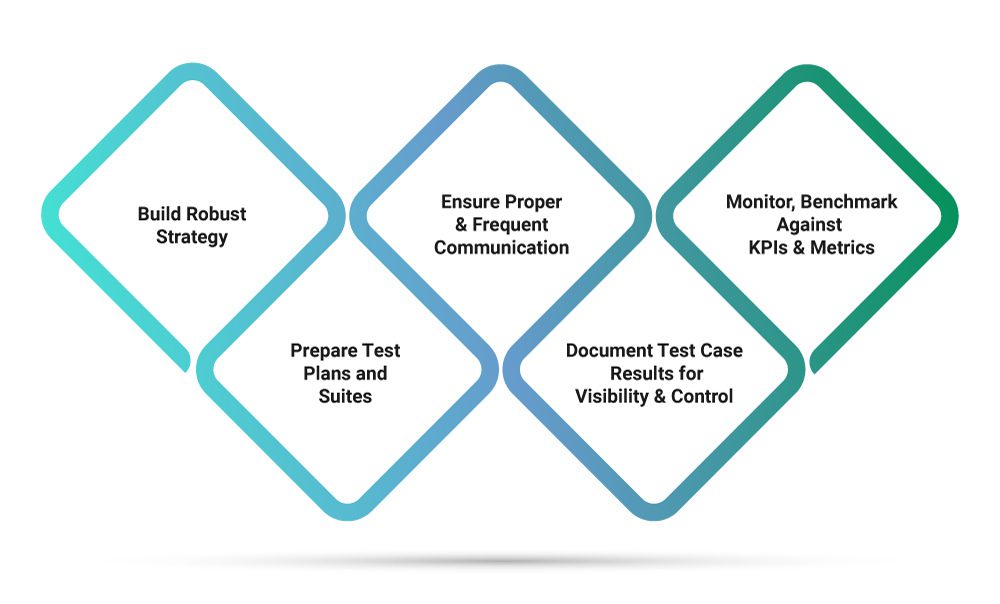Blog
Articles to grow your career
Article
Challenges in Manual Testing and How to Overcome Them
The primary objective of software solutions, websites, and apps is to cater to the needs of people. Hence, it’s safe to say that only people can determine these products’ effectiveness and the necessary improvement they require. Therefore, subjecting the software or app to comprehensive testing by a qualified QA professional or test engineer before releasing it to the public is crucial.
During manual QA testing, testers assess an application’s appearance and behavior with little automation to assist their efforts. This process can be challenging, leading to delayed releases, overlooked defects, and lower-quality products. As the manual app testing process is crucial, it’s vital to be aware of these challenges. This article will cover four significant challenges of manual app testing and how to overcome them.
Challenge: Time-Consuming
Testing apps and software within a limited time frame pose a significant challenge. For example, it may only be feasible to examine the software and app after its release thoroughly, or there may be a tight deadline to meet. Therefore, manual testers must maximize their efficiency and effectiveness in such cases while adhering to the time constraint.
There are several ways to tackle this challenge. QA testers typically turn to parallel testing and automation as the most obvious and effective solutions to break the cycle of time constraints, insufficient testing, and delayed release. Test automation enables teams to accomplish more in less time while maintaining the commitment to the release date without compromising quality. The integration of QA automation can automate repetitive and tedious tasks, freeing skilled quality engineers to focus on more complex and critical test cases.
Challenge: Cost-Ineffective
QA manual testing can be costly and resource-intensive, requiring human testers to conduct tests instead of automation tools. This can lead to time-consuming, labor-intensive, and error-prone testing processes, making scaling challenging for large and complex app and software projects. Moreover, testing costs can increase significantly if the software needs to be tested on multiple platforms and devices.
A few approaches can be taken to mitigate manual testing’s cost-ineffectiveness. Firstly, automating as much of the testing process as possible can improve the efficiency of the testing process. Secondly, a test management tool can help organize and track test cases, defects, and results, streamlining the testing process and reducing the risk of errors faced by testers. Finally, having a clearly defined testing strategy is crucial. It ensures comprehensive testing of all aspects of the application and assists in identifying the key areas that require testing.
Do you want to join us?
Leave an application and get a free consultation from our manager.
- Help in choosing a direction
- Course consultation
- Additional materials for the start
Challenge: Human Bias
A human bias refers to a patterned deviation in thinking that impacts how individuals process and make judgments about information, leading to errors in decision-making. For example, the brain’s limitations often lead to cognitive biases as it tries to simplify information processing by using heuristics or rules of thumb to make sense of the world quickly.
One common instance of this bias occurs during manual testing when testers test only the cases they believe will work. Unfortunately, this approach leads to imperfect testing and the practice of passing on code to others to clean up. Overcoming this bias requires acknowledging limitations and emphasizing testing the fragile parts of the code.
In addition, to ensure a comprehensive system assessment, it is recommended to use multiple testing methods instead of relying solely on one type, such as black-box or white-box testing. It is also important to test with a diverse group of users, including those with varying skill levels, experiences, and backgrounds, to ensure the system meets the needs of all users. Plus, testing in various environments, such as different browsers, operating systems, and devices, will ensure the system’s proper functionality in all cases.
Challenge: Test Data Management
Managing test data is one of the major challenges faced by QA testers during manual testing due to the need to test with different data sets. Obsolete test data management practices also lead to a scenario where test data needs to catch up with both the automated testing and the systems being tested. This reduces testing coverage and agility, causing tests to fail due to a discrepancy between outdated test data and the current system.
To overcome this challenge, it is crucial to have a solid plan in place. A comprehensive plan should involve using a test data management tool to enhance testing effectiveness while reducing the time and cost of providing high-quality test data. By implementing a test data management strategy and using industry tools, manual work involved in identifying, transforming, deploying, and maintaining reusable test data sets can be eliminated, resulting in significant time and cost savings.
In addition, creating a test data repository can ensure that test data is well-organized and accessible while preventing loss or corruption. Developing a test data management plan that documents creating, managing, and storing test data is also essential to ensure that test data management is carried out consistently and efficiently. With the implementation and integration of these best practices, manual testing can be more effective and efficient, resulting in better-quality hardware and software products.
Conclusion
Assessing software applications through manual testing is crucial to deliver a positive user experience to your customers. Nonetheless, the manual testing method may pose challenges that can make it challenging. However, overcoming these challenges can result in a more efficient software development process. Implementing these strategies will improve the effectiveness of the manual testing process and ensure successful hardware and software testing overall.
If you wish to explore the benefits of manual and automated testing, contact Spincareer today.






